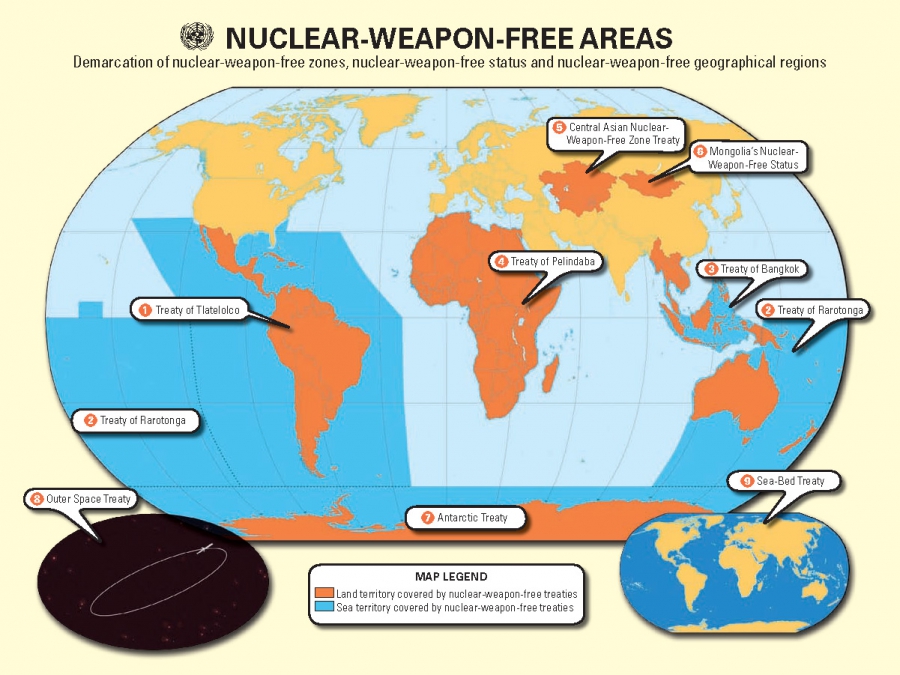Overview of Nuclear-Weapon-Free Zones

Visual illustration of the nuclear-weapon-free zones
Image source: UN Office for Disarmament Affairs
Concept of nuclear-weapon-free zones
There are currently five Nuclear-Weapon-Free Zones (NWFZs), covering territories in most of the Southern Hemisphere and in Central Asia. Antarctica and Mongolia have a special nuclear-weapon-free status as well.
Nuclear-Weapon-Free Zones are an important regional approach to strengthening global nuclear non-proliferation and disarmament norms and consolidating international efforts towards peace and security.
Within the respective territories of the zones, the Treaties establishing NWFZs prohibit the acquisition, possession, placement, testing and use of such weapons.
In addition, States Parties to the Treaties establishing NWFZs are exerting efforts to formalize legally binding agreements that would prevent nuclear-weapon States from using or threatening to use nuclear weapons against any countries that are part of the zones.
As described by the Secretary-General in his Disarmament Agenda, “Nuclear-Weapon-Free Zones are “landmark instruments” that represent an excellent example of the synergy between regional and global efforts towards a world free of nuclear weapons”. Although Nuclear-Weapon-Free Zones should not be considered ends in themselves, each of these regional agreements adds significant value to the collective efforts to achieve a more peaceful and stable world”.
|
“First and foremost, nuclear-weapon-free zones put a permanent end to the possibility of nuclear conflict in a given region… At the same time, these zones can provide additional assurance to the global community of the peaceful nuclear intentions of the countries in these regions.” Secretary General’s remarks at the Conference on the Establishment of a Middle East Zone Free of Nuclear Weapons and Other Weapons of Mass Destruction, 18 November 2019 |
The following treaties govern the five existing NWFZ:
- Treaty of Tlatelolco – Treaty for the Prohibition of Nuclear Weapons in Latin America and the Caribbean (1967)
- Treaty of Rarotonga – South Pacific Nuclear Free Zone Treaty (1985)
- Treaty of Bangkok – Treaty on the Southeast Asia Nuclear Weapon-Free Zone (1995)
- Treaty of Pelindaba – African Nuclear-Weapon-Free Zone Treaty (1996)
- Treaty on a Nuclear-Weapon-Free Zone in Central Asia (2006)
Each of the above five regional NWFZ treaties contains associated protocols seeking security assurances from the five nuclear-weapon States that they will not use or threaten to use nuclear weapons against NWFZ member States. Signature and ratification of these protocols by the nuclear-weapon States are at varying stages of completion.
In 1992, Mongolia declared its nuclear-weapon-free status which has been recognized internationally through UN General Assembly resolution 55/33S on "Mongolia's international security and nuclear weapon free status" (adopted on 20 November 2000).
There is currently renewed interest in the establishment of new NWFZ. In 2018, the General Assembly decided (A/73/546) to convene a conference on the establishment of a Middle East zone free of nuclear weapons and other weapons of mass destruction.
Other treaties that deal with the denuclearization of geographical regions:
- Antarctic Treaty(1959)
- Outer Space Treaty – Treaty on Principles Governing the Activities of States in the Exploration and Use of Outer Space, including the Moon and Other Celestial Bodies (1967)
- Moon Agreement – Agreement Governing the Activities of States on the Moon and Other Celestial Bodies (1979)
- Seabed Treaty – Treaty on the Prohibition of the Emplacement of Nuclear Weapons and Other Weapons of Mass Destruction on the Sea-Bed and the Ocean Floor and in the Subsoil thereof (1971)
Definitions and principles for establishment of a nuclear-weapon-free zone
Article VII of the Treaty on the Non-Proliferation of Nuclear Weapons (NPT) states: “Nothing in this Treaty affects the right of any group of States to conclude regional treaties in order to assure the total absence of nuclear weapons in their respective territories.”
General Assembly resolution 3472 B (1975) defined a Nuclear-Weapon-Free Zone as:
“...any zone recognized as such by the General Assembly of the United Nations, which any group of States, in the free exercises of their sovereignty, has established by virtue of a treaty or convention whereby:
(a) The statute of total absence of nuclear weapons, to which the zone shall be subject, including the procedure for the delimitation of the zone, is defined;
(b) An international system of verification and control is established to guarantee compliance with the obligations deriving from that statute.”
The UN Disarmament Commission in its report of 30 April 1999, recommended a set of principles and guidelines for the establishment of a nuclear-weapon-free zone, including:
- Nuclear-weapon-free zones should be established on the basis of arrangements freely arrived at among the States of the region concerned.
- The initiative to establish a nuclear-weapon-free zone should emanate exclusively from States within the region concerned and be pursued by all States of that region.
- The nuclear-weapon States should be consulted during the negotiations of each treaty and its relevant protocol(s) establishing a nuclear-weapon-free zone in order to facilitate their signature to and ratification of the relevant protocol(s) to the treaty, through which they undertake legally binding commitments to the status of the zone and not to use or threaten to use nuclear weapons against States parties to the treaty.
- A nuclear-weapon-free zone should not prevent the use of nuclear science and technology for peaceful purposes and could also promote, if provided for in the treaties establishing such zones, bilateral, regional and international cooperation for the peaceful use of nuclear energy in the zone, in support of socio-economic, scientific and technological development of the States parties.

